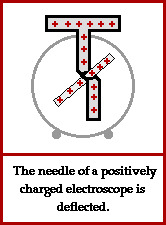Grounding a Positively Charged Electroscope
An electroscope is a charge-detecting device which depicts the presence of a charge on the apparatus itself or upon other objects in the nearby vicinity. The presence of a charge on an electroscope is depicted by the deflection of its needle from its usual upright position. The needle, being free to rotate about its pivot, will be deflected whenever the charge in the needle is the same as the charge in the upright support upon which it balances. Since the electroscope plate, support, and needle are connected and made of a conducting material, any charge upon the electroscope will be distributed throughout the entire conductor. Thus, if an electroscope acquires an overall positive charge, this positive charge will be spread about the entire electroscope - plate, support and needle. Since like charges repel, the positively charged support and the positively charged needle will repel each other, causing a deflection of the needle.
When the positively charged electroscope is touched, its charge becomes grounded (or neutralized). This is depicted in the animation below. The grounding process involves a transfer of electrons between the charged electroscope and the conducting object to which it is touched. When a positively charged electroscope is touched, electrons enter the electroscope from the ground. Being positively charged, the electroscope attracts some electrons from the conducting material (in this case, a person). The negatively charged electrons enter the electroscope and neutralize the positive charge. As the electroscope loses its charge, the needle relaxes back to its naturally upright position.

Additional information on physical descriptions of electrostatic phenomenon is available at The Physics Classroom Tutorial. Detailed information is available there on the following topics:
Neutral vs. Charged Objects
Charge Interactions
Grounding - the Removal of a Charge